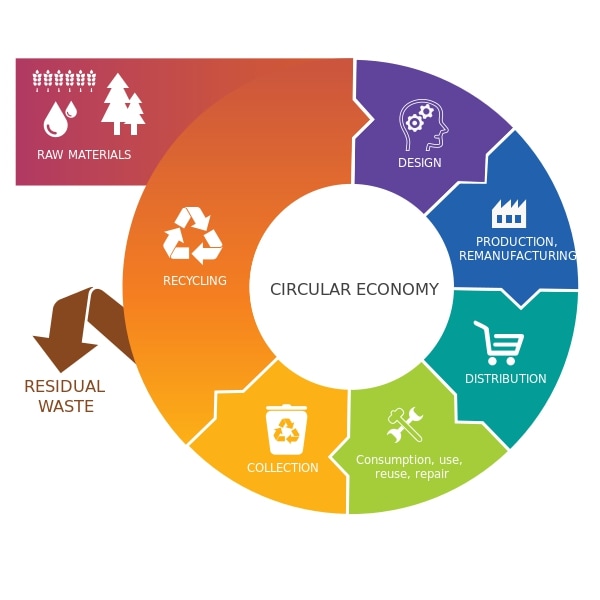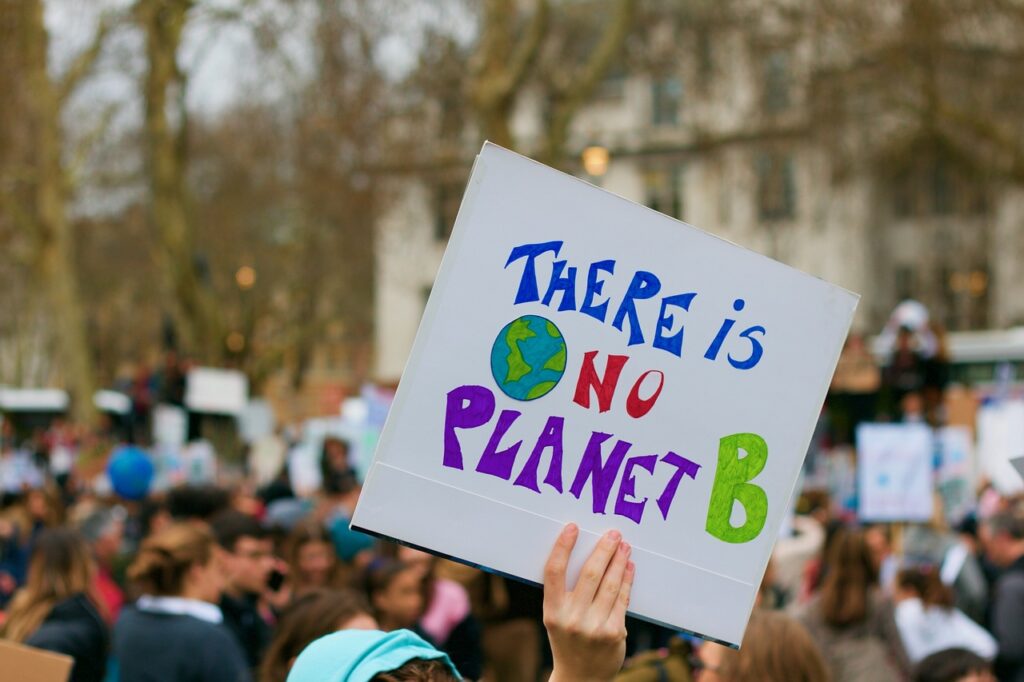Climate Goals Overview
Year after year, countries around the world come together and declare their climate goals. This year, COP27 in Egypt marks the 30th anniversary of the United Nations Framework Convention on Climate Change. Traditionally, efforts to reduce global temperatures and greenhouse gas emissions have been through renewable energy targets and energy efficiency metrics. Although necessary and crucial, these metrics only address 55% of emissions output, not accounting for the remaining 45% that comes from the production of products that are used everyday such as cars, clothes, food, and electronics. To date, there is little discussion on how the adoption of a circular economy can assist in meeting GHG reduction targets. Below, we’ll describe how, through the lens of zero waste.
What is the Circular Economy and how can it help us meet climate goals?
In a circular economy, things are produced, consumed, and ultimately disposed of in a way that conserves and restores the planet’s natural resources. It follows the principles of zero waste. The circular economy eliminates waste upstream and downstream by designing products to last through repair, redesign, and recycling methods. This reduces overall greenhouse gas emissions across sectors. According to Zero Waste Europe, over 70% of global GHG emissions comes from the material economy, from extraction to disposal.

The move away from the traditional linear take-make-dispose model to the circular economy model of reduce, repair, redesign, and reuse is a clear way to close emissions gap that was laid out at COP27, and reflects the Rs of zero waste.
The World Resources Institute and their partners on the Working Paper have produced a study outlining the steps needed to meet such climate goals by adopting circular economic practices throughout the built environment, transportation, food systems, and energy sectors. We need to:
-Reduce greenhouse gas emissions through supply chains
-Increase the sustainable expansion of renewable energy technologies
-Increase climate mitigation and meet adaptation needs
Reducing Greenhouse Gas Emissions
Adopting circular economic strategies significantly reduces the demand for finite and virgin materials. According to a report by the Ellen MacArthur Foundation, repairing, redesigning, and reusing products already in the economy can help reduce global emissions by half by reducing the extraction and manufacturing of materials.
The sectors with the largest input and output of waste lie in the construction, transportation, and food sectors. Tackling these with circular design models can have the largest scale for impact from all aspects of the supply chain — from production, to manufacturing, to use, and disposal. Instead of designing products for production and disposal, they should be redesigned for repair. This will have the most significant impact in reducing consumption patterns and global emissions.
Circular Economy and Clean Energy
The demand of natural resources for the production and expansion of the renewable energy sector is growing. Because of this, it is imperative to include circular models in the design, production, and end-of-life planning. This way, we can alleviate the need for raw materials and extend the useful life of our solar panels and windmills. Placing emphasis on increasing a product’s life through repair and refurbishment could help us avoid a multitude of waste challenges.
We can avert upstream waste by diminishing supply pressure, and downstream waste by reducing what requires disposal. This is as true for large-scale energy production as it is for individual electric vehicle batteries. Repairing and refurbishing available equipment could also increase the adoption of clean energy, such as home solar or wind, by reducing costs through a refurbished goods market. Overall, the circular economy increases climate benefits by minimizing the demand for production of raw materials by roughly 10%. We arrive at zero waste and zero emissions by reducing the amount of raw resources required.
Increasing Climate Adaptations
According to the World Resources Institute, 90% of earth’s biodiversity and water scarcity is due to the extraction and processing of raw materials. Undoubtedly, the circular economy can slow down and reverse these adverse effects on the planet. Investing the resources and time for circular models can significantly reduce the degradation of land and ocean. It can repair biodiversity loss and improve natural systems, such as soil health, through regenerative agriculture. It can improve climate resiliency by reducing the impacts of food and water loss after disastrous climate events. Reducing the demand for resources increases their availability.
Conclusion
It is clear that in order to meet climate goals and global emission targets, countries need to begin investing in the infrastructure for a circular economy. There needs to be a clear push for industries to change their current linear, take-make-waste model to a circular one. We need an economy that prioritizes repair, refurbishment, and product redesign. Without doing so, we will create more waste and degrade the planet further.
As climate talks are at the forefront of our leaders’ minds, we urge you to participate in the call to action. We, as a community must make our voices heard. We demand a sustainable and livable circular economy in all current and future global climate action planning.
Want some ideas for taking personal action for the climate? Check out our blog from Climate Action Month.
This article was written by Outreach Coordinator, Daniella Menendez.
Do you find articles and blogs from R20W valuable? Consider making a donation.

